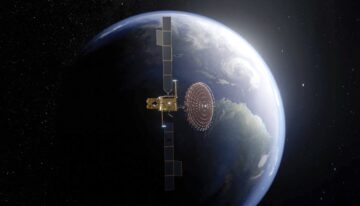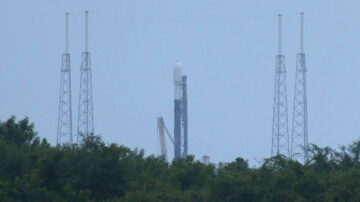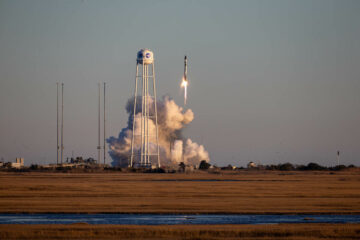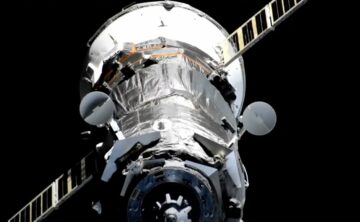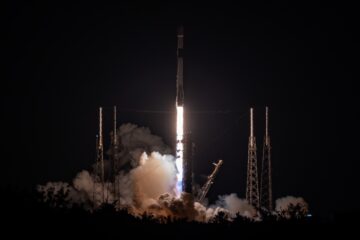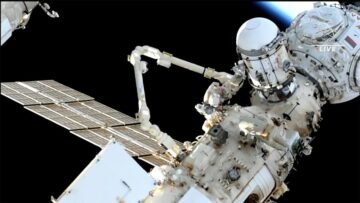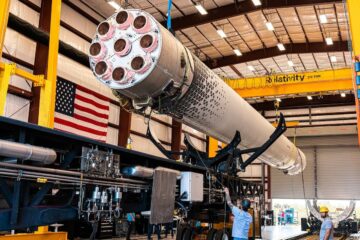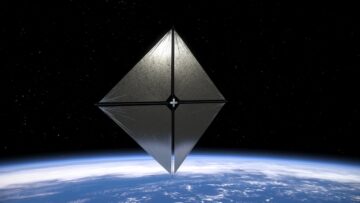Europe’s venerable Ariane 5 rocket blasted off on its 117th and final flight Wednesday, successfully boosting two communications satellites into orbit but leaving the European space program without a large satellite launcher of its own until a delayed successor comes on line.
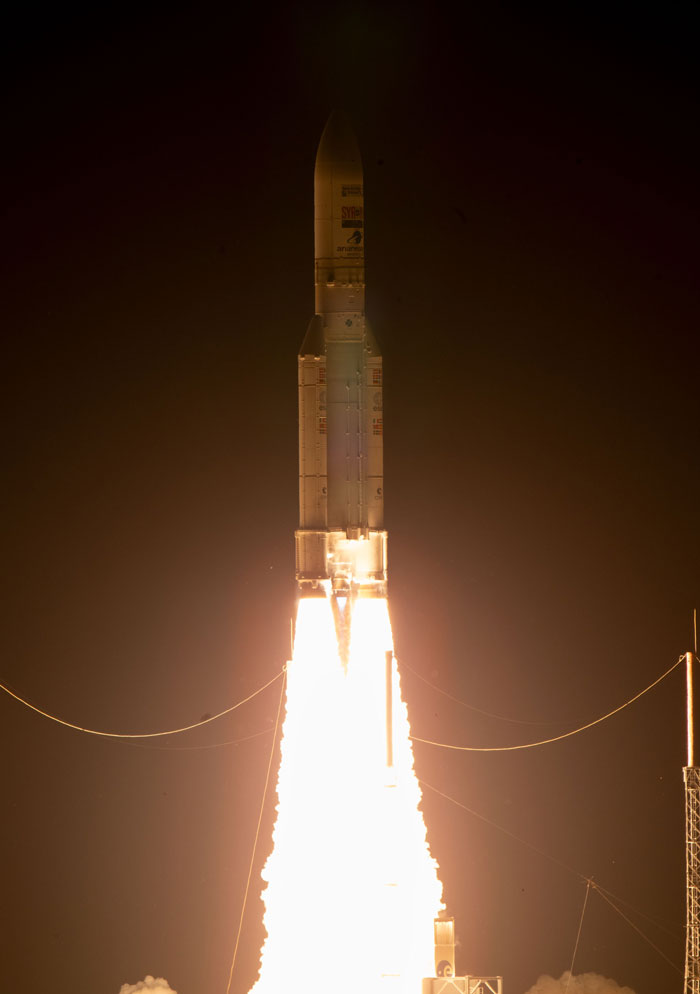
The 165-foot-tall Ariane 5, equipped with two strap-on solid-fuel boosters and two hydrogen-fueled core stages, blasted off from the Guiana Space Center near Kourou, French Guiana, at 6 p.m. EDT, knifing through a cloud deck as it arced away to the east over the Atlantic Ocean.
A half hour later, the rocket’s payload of two communications satellites — Germany’s Heinrich-Hertz-Satellit testbed and the French military’s SYRACUSE 4B — were released one at a time to fly on their own in an initially elliptical orbit.
Both will use on-board propulsion to reach a circular “geosynchronous” altitude 22,300 miles above the Earth where satellites take 24 hours to complete one orbit and thus appear stationary in the sky, allowing the use of fixed antennas on the ground.
“This is the last time we’re doing this, and we would be lying if we said we’re not tearing up a bit, this is the last live tweet of an Ariane 5 launch!” tweeted the rocket’s builder, ArianeGroup.
🥹 This is the last time we’re doing this, and we would be lying if we said we’re not tearing up a bit, this is the last live tweet of an Ariane 5 launch! @Arianespace #ArianeGroup #VA261 #OneLastAriane5 https://t.co/leUtZFh0l4 pic.twitter.com/y29o2l6zh9
— ArianeGroup (@ArianeGroup) July 5, 2023
Including Wednesday’s flight, the Ariane 5’s final tally was 112 fully successful missions in 117 flights, putting 239 satellites and science probes into space, including NASA’s $10 billion James Webb Space Telescope.
“After 27 years, the mighty Ariane 5 is hanging up her boots and retiring to hand over to her younger sister, Ariane 6,” said Arianespace webstream host Katy Haswell. “Very exciting times ahead.”
But the rocket’s retirement marks a major shift in the international launch marketplace, leaving Europe without a heavy-lift rocket until the lower-cost Ariane 6 becomes available, likely in 2024.
ESA and the French joint venture ArianeGroup originally hoped to have the Ariane 6 flying in the 2020 timeframe, providing a cheaper, more competitive alternative to SpaceX’s partially reusable Falcon 9 rocket and the huge Super Heavy-Starship currently in development.
But the Ariane 6 program has been repeatedly delayed, often without explanation. In the meantime, with Russian Soyuz rockets off limits because of Ukraine invasion sanctions, American rockets, primarily SpaceX’s, offer the only near-term solution for heavy European payloads.
Last Saturday, SpaceX successfully launched ESA’s $1.5 billion Euclid space telescope from Cape Canaveral. It was originally intended to launch atop a Soyuz only to lose its ride after Russia’s invasion of Ukraine. ESA also now plans to launch its Hera asteroid probe on a Falcon 9 in 2024.
“SpaceX has undeniably changed the launcher market paradigm as we know it,” ESA Director General Josef Aschbacher wrote in May. “With the dependable reliability of Falcon 9 and the captivating prospects of Starship, SpaceX continues to totally redefine the world’s access to space.”
Europe, he wrote, “finds itself today in an acute launcher crisis with [an albeit temporary] gap in its own access to space and no real launcher vision beyond 2030.”
If there is a silver lining to this “true crisis,” Aschbacher said, it has forced Europe “to candidly reflect on the causes and decisions that brought us here, draw the subsequent and necessary painful lessons, and come out stronger than before. More resilient, more clever, more visionary.”
He said the near-term priority is to “ensure the successful inaugural flight of Ariane 6. … Once operational, I am convinced that Ariane 6 will be an excellent launcher for many years to come, continuing the performance of Ariane 5 at significantly lower cost to satisfy European and commercial needs. ”

The Ariane 6 will provide similar performance as its predecessor, able to lift two communications satellites at a time, weighing a combined 21,000 pounds, to geosynchronous orbit.
The new rocket also will fill a variety of other roles, helping launch Amazon’s Kuiper internet relay satellites, Europe’s Galileo satellite navigation constellation and other payload combinations.
Depending on the configuration, the Ariane 6 is expected to cost between $70 million and $125 million per flight. While more competitive with the Falcon 9, it will not be even partially reusable. Projections show it will not fly often enough to make booster recovery, refurbishment and re-launch cost effective.
- SEO Powered Content & PR Distribution. Get Amplified Today.
- PlatoData.Network Vertical Generative Ai. Empower Yourself. Access Here.
- PlatoAiStream. Web3 Intelligence. Knowledge Amplified. Access Here.
- PlatoESG. Automotive / EVs, Carbon, CleanTech, Energy, Environment, Solar, Waste Management. Access Here.
- BlockOffsets. Modernizing Environmental Offset Ownership. Access Here.
- Source: https://spaceflightnow.com/2023/07/06/ending-an-era-europe-launches-its-final-ariane-5-rocket/
- :has
- :is
- :not
- :where
- ][p
- $UP
- 000
- 2020
- 2024
- 2030
- 22
- 24
- 27
- 300
- 9
- a
- Able
- above
- access
- After
- ahead
- Allowing
- also
- alternative
- am
- america
- American
- an
- and
- appear
- article
- AS
- Asteroid
- At
- available
- away
- BE
- because
- becomes
- been
- before
- between
- Beyond
- Billion
- Bit
- booster
- BOOSTERS
- boosting
- Boots
- brought
- builder
- but
- captivating
- causes
- Center
- centre
- changed
- cheaper
- Cloud
- combinations
- combined
- come
- comes
- commercial
- Communications
- competitive
- complete
- Configuration
- continues
- continuing
- convinced
- Core
- Cost
- crisis
- Currently
- decisions
- Delayed
- dependable
- Development
- Director
- doing
- draw
- earth
- East
- Effective
- enough
- equipped
- Era
- ESA
- Europe
- European
- Europes
- Even
- excellent
- exciting
- expected
- explanation
- falcon
- Falcon 9
- fill
- final
- fixed
- flight
- Flights
- flying
- For
- forced
- French
- from
- fully
- gap
- General
- Ground
- Half
- hand
- Have
- he
- heavy
- helping
- her
- here
- host
- hour
- HOURS
- http
- HTTPS
- huge
- i
- if
- image
- in
- Inaugural
- Including
- initially
- intended
- International
- Internet
- into
- invasion
- IT
- ITS
- itself
- james
- James Webb Space Telescope
- joint
- joint venture
- jpg
- Know
- large
- Last
- later
- launch
- launched
- launches
- leaving
- Lessons
- likely
- limits
- Line
- lining
- live
- lose
- lower
- major
- make
- many
- Market
- marketplace
- max-width
- May..
- meantime
- mighty
- million
- missions
- more
- Navigation
- Near
- necessary
- needs
- New
- no
- now
- ocean
- of
- off
- offer
- often
- on
- once
- ONE
- only
- operational
- Orbit
- originally
- Other
- out
- over
- own
- pad
- painful
- paradigm
- per
- performance
- Place
- plans
- plato
- Plato Data Intelligence
- PlatoData
- pounds
- predecessor
- primarily
- priority
- probe
- Program
- projections
- propulsion
- prospects
- provide
- providing
- Putting
- RE
- reach
- real
- recovery
- reflect
- released
- reliability
- REPEATEDLY
- resilient
- retirement
- reusable
- Ride
- rocket
- roles
- russian
- s
- Said
- Sanctions
- satellite
- satellites
- saturday
- Science
- shift
- show
- significantly
- Silver
- similar
- sister
- sky
- solution
- South
- South America
- Space
- space telescope
- SpaceX
- stages
- starship
- stronger
- subsequent
- successful
- Successfully
- summer
- Super
- Take
- taking
- Tally
- telescope
- temporary
- test
- than
- that
- The
- their
- There.
- this
- Through
- time
- timeframe
- times
- to
- today
- TOTALLY
- true
- tweet
- two
- Ukraine
- until
- us
- use
- variety
- venture
- vision
- visionary
- was
- we
- Wednesday
- weighing
- were
- while
- will
- with
- without
- world’s
- would
- years
- Younger
- zephyrnet


